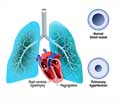Heart failure patients treated with sacubitril/valsartan did not exhibit cognitive changes compared to patients treated with valsartan.
- Heart failure patients are more likely to develop dementia
- Sacubitril/valsartan, a standard treatment for those with heart failure and previously suspected to exacerbate cognitive impairment, shows no indication of incrementally negative cognitive consequences
- This helps in eliminating concerns some doctors had about long-term treatment with sacubitril/valsartan
PERSPECTIVE was the first randomised trial to prospectively evaluate the effect of long-term treatment with sacubitril/valsartan compared with valsartan on cognitive function in patients with heart failure and mildly reduced and preserved ejection fraction (HFmrEF and HFpEF), defined as a left ventricular ejection fraction over 40%.
Demography and Study Protocol
Adults aged 60 years and above who had chronic symptomatic heart failure, heart failure hospitalisation in the last 12 months and/or NT-proBNP levels higher than 200 pg/mL were enrolled in the trial. Patients with cognitive impairment that was either known or suspected were disqualified. 592 individuals from 137 centres across 20 countries were randomly assigned to receive valsartan or sacubitril/valsartan (target dose: 97/103 mg twice daily) (target dose 160 mg twice daily). Participants’ average age was 72.4, and 46.8% were female.The improvement in cognitive function from the baseline to the three-year follow-up was the main goal. The CogState global cognition composite score (GCCS), which contains seven tasks evaluating attention, episodic memory, and executive function, was used to assess cognitive function. Patients receiving sacubitril/valsartan treatment were not different from those receiving valsartan treatment in terms of the change in GCCS from baseline to three years. There was a -0.0180 (95% confidence range [CI] -0.1230 to 0.0870; p=0.74) difference in the GCCS least-squares mean change. Non-inferiority was indicated by the Cohen’s d effect value of -0.0277 (95% CI -0.1101 to 0.0778).
Outcomes of the Sacubitril/Valsartan and Valsartan Use on Cognitive Function In Heart Failure Patients
The primary secondary outcome was the variation in amyloid deposition in the brain evaluated using PET in 491 participants from baseline to three years. The difference in the standardised uptake value ratio's least-squares mean change was -0.0292 (95% CI -0.0593 to 0.0010; p=0.058), indicating that patients receiving sacubitril/valsartan treatment tended to have less amyloid deposition in the brain than those receiving valsartan alone.“There was no evidence that neprilysin inhibition increased the risk of cognitive impairment due to accumulation of amyloid β in the brain in patients with HFmrEF and HFpEF. The concern about increased cerebral amyloid β deposition with sacubitril/valsartan was always hypothetical and multiple enzymatic and other amyloid β clearance pathways exist in the brain that would likely compensate for any decreased clearance related to neprilysin inhibition. The trend towards decreased amyloid deposition on PET scanning is a surprise and may just reflect the play of chance. The absence of any negative effect on cognitive function is very important in removing a concern some doctors had about long-term treatment with sacubitril/valsartan,” said study author Professor John McMurray of the University of Glasgow, UK.
















